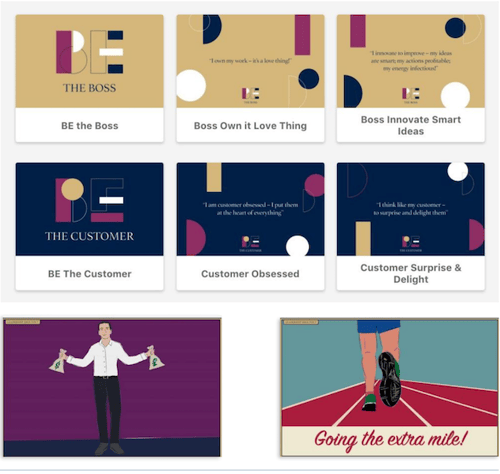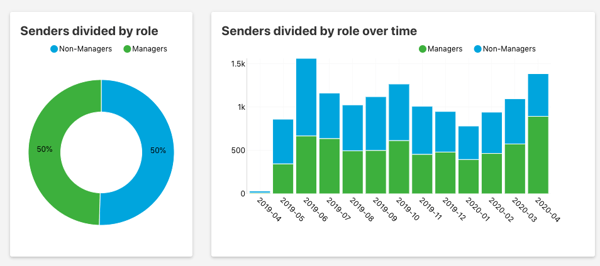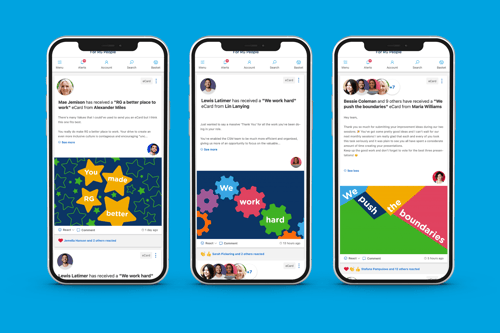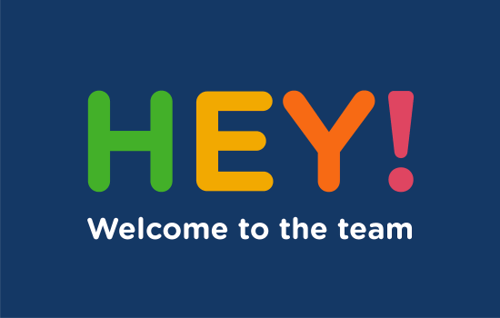While priorities for many organisations have shifted as a result of economic concerns and a growing proportion of staff now working remotely, the need to engage with your employees hasn’t changed - if anything it’s intensified.
According to our latest research, The Workplace Connection Report, over two thirds of employees feel disconnected from their workplace. Some don’t feel motivated or valued by their employers, some feel invisible at work, and many are lacking recognition for the work they do.
The same study revealed that 54% of employees wanted their employers to improve their recognition programme. It’s more important than ever before to make sure your people feel motivated and connected to your organisation, and a solid recognition programme can go a long way to achieving this.
54% of employees believed better recognition would help them feel more connected to their work.
10 ideas for employee recognition programmes
1. Engage leaders in the programme
Leaders are key drivers of company culture and strong examples of behaviour in the workplace. When top-level executives support (and use!) strategic recognition, managers and employees are more likely to participate, as well, setting a reward and recognition culture.

In order to launch a successful employee recognition programme, getting your leaders on-board and securing that buy-in is crucial. One of the best examples of employee recognition that achieved this are Charles Tyrwhitt, who gave their leaders their own personalised recognition tools. This added extra value to their eCards this way and encouraged their employees to earn a card from each of the business leaders.
2. Connect your company values to concrete behaviours
Your company values define who you are, what is important to you and how you manage expectations on the day-to-day. They are also a strong employee engagement tool, helping to bring teams together and give your employees a singular, defined direction to go.
When employees understand these values, and can observe them in action in the workplace (no matter where 'work' might be right now), they are more likely to go above and beyond.
But in order for your employees to connect with your values, they have to be accessible, digestible, realistic and relatable. Companies that develop their values with input from employees, and that make values relevant to employees’ actual work, are more likely to see better engagement and performance.

3. Centralise engagement tools
As with any technology you implement, centralisation is key. You want to make it easy for your employees to adopt recognition practices, so it is important to give them a system that easy-to-use and log into. If they have to remember how to use the program every time, they are unlikely to use it at all, especially when your typical employee might be using several digital tools at once.
Choosing an employee recognition programme that is completely customisable to your company’s needs can help your teams feel even more connected to the reward and recognition ideas you decide to put in place.
4. Train managers on why recognition matters
In order to avoid any pushback when implementing your recognition programme, it goes without saying that you have to get managers on board. This can be done by educating them on the benefits of strategic recognition and the importance of shining a spotlight on the daily successes others in the business might not know about.
But training is just the first step. Ensuring that managers actually use your programme is even more critical. Employers can hold managers accountable by setting expectations and goals. For example, you may request that managers write at least one recognition per month. You can then track the usage of your recognition platform, to ensure they are keeping pace.

5. Implement a measurement strategy
Most things in life are all about execution. And your employee recognition ideas are no exception. By raising awareness and incentivising your employees to use your system from the get-go, you can generate an instant impact. If it gets off to a great start, chances are you’ll be in a much better position to maintain usage as time goes on.
You could generate some initial buzz by asking your team to help you name your recognition program. Then you could run a competition to see how many recognition moments you can record in the first 30 days of the launch.
6. Make it social
Making employee recognition and rewards visible across your organisation can work wonders for not only engaging your employees, but in maintaining a healthy uptake of your recognition systems. Inviting employees to respond to the recognition their fellow employees receive on the social wall, whether it’s through a comment or a like, helps generate more excitement about what your people are working on.

That visibility is fantastic for helping break down silos among teams – the more employees see of each other, the better. When we can communicate and recognise one another publicly for everyone in the business to see, other departments and teams are kept in the loop about big projects. This is ideal if your teams are dispersed, working in different locations across the country and the world, and an example of how technology can be the glue that keeps us together.
7. Ease-of-use is everything
If you want your teams to take to your recognition tools like a duck to water, accessibility is key. Our clients are most successful when they put recognition where employees already are. Whether that’s an integration with MS teams or Slack, or something simple like having the programme automatically load when employees open a browser on their computer, the uptake is much higher.
It might also be important for your company to consider those employees who aren’t working with computers or mobile devices. In these cases, you could kickstart your in-person meetings with recognition stories, provide paper recognition forms that can be entered online, or even offer rewards that can be handed out on postcards and then redeemed online.
Making it easy to use should also be a requirement for you and the rest of the HR teams. Despite the advancement of AI in recent years, automation is still a tool that is not fully utilised by HR and People teams. But when it comes to recognition, you can set up automatic milestone recognition, including birthdays and work anniversaries. This means everyone gets some recognition at every milestone, without the need for you and your managers to remember every date.
8. Recognition starts from Day 1
Recognition should be tied into an employee’s first day of work. All new employees should be educated on how recognition works in your company, and what your company values and expectations are.
When these are introduced during the onboarding process, you set new hires up for success. They will benefit from hearing other recognition stories and observing examples of recognition within the company. Most of all, by understanding your company values, they will better understand the desired behaviours that are likely to be rewarded over time.
9. Fold values and recognition training into induction
In order to ensure your recognition programme is successful, and to retain buy-in from leadership, you must be able to measure its impact and provide tangible results. There are a number of metrics you could consider: employee turnover, attendance and even recognition tool usage.
But perhaps the most effective way to measure the impact of your recognition programme is through employee surveys. This valuable tool can be used to measure employee satisfaction, which can be tracked and reported on over time. Measuring this year-over-year can be a great indicator of just how effective your efforts have been. And, if you can prove a successful ROI from some low cost recognition ideas, you might gain the buy-in to launch more ambitious recognitions tools in future.
10. Revisit and refresh
Much like companies, employee recognition and rewards have to evolve over time. If a recognition programme stays the same for too long, employees may lose motivation over time and you could see your engagement levels revert back to how they used to be.
Make sure to regularly review your recognition programme and where necessary refresh it by leveraging your best asset - feedback from your employees. Also, what was right for your company in the past may not be right for the future. So, if your company goals, values or working conditions change, be sure your programme is updated to be aligned with these. It’s always a good idea to keep a bank of reward and recognition ideas for the future.
If you’ve transitioned to a remote-first workforce in recent years, why not implement some new eCards that reflect this and encourage your employees to use them? For instance, if a core focus in your business is safety for on-site employees, you might use new eCards or other employee recognition ideas to embed these behaviours into an employee's daily routines.
As we navigate a landscape of disconnection and financial uncertainty, think about which of these employee recognition best practices will have the biggest impact on your people to build connections, boost morale and improve employee engagement.
Speak with one of our team today to find out how we can help you launch a winning recognition programme to build long-lasting connections within your organisation.
Talk to an Engagement Consultant »

%20(1).jpeg) Alexandra Powell
Alexandra Powell
